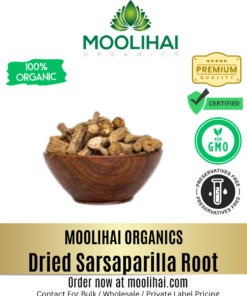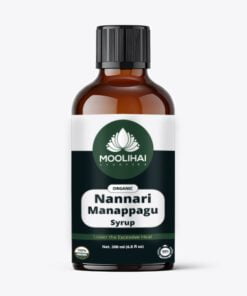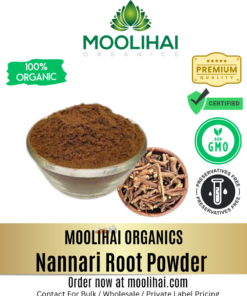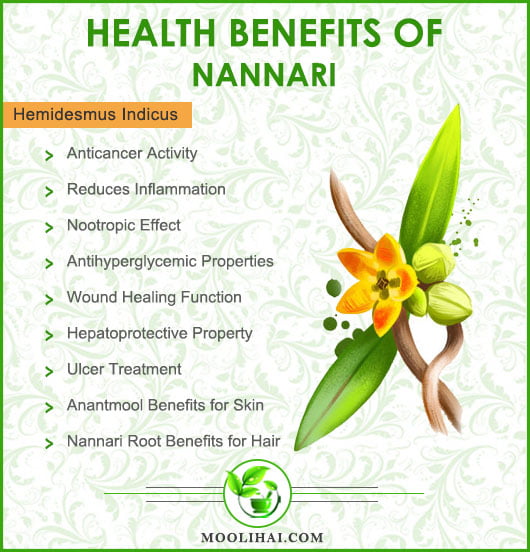Guide
Anantmool (Hemidesmus Indicus): Uses, Health Benefits, Side Effects
What is Anantmool?
The Sarsaparilla or Anantmool herb is widely known as Nannari in India. As it has a cooling property, it is a perfect one for this summer. The syrup made by this root is known as Nannari syrup. Ancient people use this hemidesmus indicus root extract with lime juice and a pinch of sugar (panam kalkandu). This drink can cool their body during the summer season. You can also alternatively use white sugar for palm sugar. Its root comes in brown color, and inner parts are whitish. The root gives astringent taste and offers pleasant odor.
For centuries, the sarsaparilla plant is used to cure joint problems such as arthritis and to treat skin problems such as psoriasis, eczema, and dermatitis. It is also believed to treat leprosy due to its “blood purifying” properties.
In European medicine, Sarsaparilla was introduced and registered as a herb in the US.
Common Names of Sarsaparilla / Anatmool / Nannari / Hemidesmus Indicus
- Botanical Name: Hemidesmus indicus
- Tamil Name: Nannari
- English Name: Indian Sarsaparilla
- Hindi Name: Anantmool, Kapuri, anantamul
- Kannada Name: Sogade Beru
- Malayalam Name: Naruninti
- Telugu Name: Sugandhipala, muttavapylagamu
- Marathi Name: upalsari, uparsal
- Gujrati Name: kapuri, upalasari, Maduri
- Sanskrit Name: Sariva, Ananta , Asfota, Utpal sariva, Shyama, Canadana. Gopi, Gopavalli etc.

Hemidesmus Indicus Plant Description
The botanical name of the anantmool is Hemidesmus indicus, which comes under the Asclepiadaceae family. You can find this plant throughout the tropical and subtropical regions of India. The leaves of this herb grow up to 2.5 inches length. The upper part of the leaves comes with an oval shape, which is very soft. The stem comes cylindrical with thick nodes. Its wood roots provide an excellent aromatic flavor. The flower of this herb is cluster yellow and greenish purple in color.
It is also called Sariva. It can cure many diseases of the female reproductive system. It is one of the excellent natural detoxification herbs that can help to maintain your health naturally. It can be used both externally and internally to cure some skin diseases like thrush, eczema, ringworm, psoriasis, etc. The powder root is combined with cow’s milk, which treats very low and high colored urine, in folk medicine.
Anantamul can balance your blood sugar levels as well as protect the liver from any damage. It increases the metabolism of the body and improves the digestive system function. If you want to reduce your weight, you can consume nannari (Sariva) sarbath daily.
Hemidesmus indicus includes some medicinal properties that are anti-cancer activity, chemopreventive activity, immune-modulatory activity, healing power, antioxidant properties, anti-diarrheal activity, anti-leprosy activity, and antitoxin activity.
The Chemical Constitution of Sugandhipala
Hemidesmin-1, H.Indicus-Hyperoside, B-Sitosterol, Desinine, Hemidesmin-2, Rutin, Hexatriacontance, Hemidesminine.
Ayurvedic Properties of Sugandhi roots
Rasa (Madhura, Tikta) Sweet, Bitter
Guna (Guru, Snigdha) Heavy, Unctuous
Virya (Sheeta) Coolant
Vipaka (Madhur) Sweet
Health Benefits of Hemidesmus Indicus ( Nannari)
1 Anticancer Activity
As it has anticancer properties, it can fight against breast cancer cells. Rhizomes methanolic extract effectively works against breast cancer as well as it is also used to treat colon cancer. The extract of the root can show significant cytotoxic activity against Ehrlich Ascites Tumor. Elements of endocrine signaling pathways involved in cell viability, proliferation, and altered protein expression lead to cell death. It is a chemical preventive agent on the skin.
2 Reduces Inflammation
The anti-inflammatory property of the ethyl acetate root extract can fight against subcutaneous and acute inflammation. Moreover, its root extract oral administration shows antinociceptive activity and prevents neurogenic and inflammatory pain.
3 Nootropic Effect
You can get the learning power and memory by using the hemidesmus indicus as it has nootropic effects. It acts as a therapeutic memory agent to treat dementia in Alzheimer’s disease and other neurodegenerative diseases.
4 Antihyperglycemic Properties
The root extract of the sariva can decrease the glycogen content in muscle tissue. In diabetes, glycosylated hemoglobin is set with the presence of excess glucose in the hemoglobin. Therefore the level of glycosylated hemoglobin is straightly equal to the blood glucose level.
5 Wound Healing Function
One study found that the leaves of the hemidesmus indicus have wound healing properties and play an essential role in treating chronic wounds and in patients with cancer and diabetes. H. Indicus is designed as an ointment of about 5% and 10% in alcohol extracts, which enhances wound shrinkage rates.
6 Hepatoprotective Property
Fifty percent ethanol extract of hemidesmus indicus inhibits rifampicin and isoniazid combined hepatotoxicity. After oral administration and biochemical parameters, you can find the alkaline phosphatase, serum glutamate pyruvate transaminase, and serum glutamate oxaloacetate transaminase within the normal range.
7 Ulcer Treatment
As it has antiallergic activity, it can act by mucoprotective action and inhibits prostaglandins. It has low mucoprotective properties when compared with drugs such as rantidine and omeperazole.
8 Anantmool Benefits for Skin
It is very beneficial for all types of skin, and it can cure all skin ailments. To treat some skin diseases, use the anantmool face mask.
Take the anantmool root powder and add some milk, make it as a paste. Apply it directly on the face to get a bright and clear complexion. It effectively works in reducing acne scars, pits, marks, and pigmentation, which is caused by children’s pox and injury.
9 Nannari Root Benefits for Hair
Anantmool is a natural treatment for baldness and hair loss. It will benefit the new hair growth. It can reduce the scalp heat as well as scalp issues like swelling, dandruff, and itching. Ananthamul plays an essential role in most hair solutions as it has cooling effects on the scalp.
Traditional Applications of Nannari Roots
- It can be used to treat three doshas namely vata, pitta, and Kapha.
- You can apply the anantamul root paste to cure osteoarthritis and gout as well as treat all skin ailments.
- If your children have speech disorders, autism, then the anantmool is the right choice. You can also consume this anantmool, if you are affected by depression, psychiatric issues, etc.
- Smash the leaves and place them between the teeth; it can cure tooth issues and toothache.
- Instead of drinking tea or coffee, you can have the decoction of the boiled root. It gives a refreshment to your body than tea. Moreover, it is very healthy to take in the early morning.
- To get rid of gastric and asthma problems, take the leaves of each anantmool root and Malabar nut twice a day with milk.
- Consume anantmool root powder with water three times a day; it can help to enhance your hair growth.
- As it has blood purifying properties, it can effectively treat scorpion and snake bites and other venomous insect cases.
- Moreover, sarsaparilla is very beneficial for some gynecological issues like leukorrhea, menorrhagia, dysmenorrhea, etc.
- For stomach ache, use 2-3 grams of grind Anantmool root in water.
- To cure burning sensation, take 1 g of fried anantmool powder with 5 g of ghee and sugar.
- To reduce joint pain and stiffness, consume 3 grams of anantmool root powder with tea three times a day.
- If you are pregnant women and want a healthy as well as fair delivery, then consume a warm infusion of Anantmool root mixed with milk and sugar candy.
Medicinal Properties of Hemidesmus Indicus
The extract of this hemidesmus indicus is used to treat various conditions due to its medicinal properties. Here are the pharmacological properties:
- Its root extract provides antioxidant activity, anticancer effects, hepatoprotective properties, antifungal, and anti-enterobacterial effects.
- Decoction and root juices have proven anticarcinogenic properties.
- The shrub’s root extracts have proven antithrombotic properties, antihyperlipidemic property, reno-protective effect, diuretic, and natriuretic effect.
- The plant extract has anti-arthritic effects, anti-inflammatory property, anti-venom activity, and antinociceptive effect.
How to Use Hemidesmus Indicus
1 Sariva Powder
Take 1 tsp of sariva powder
Add some water or coconut oil and make it as a paste
Apply this paste directly on your scalp and hair roots. It gives relief from hair fall.
2 Anantamul Leaves Decoction
Take some leaves of anantamul and boil them with one glass of water.
Boil for up to 8 mins, keep the flame on a low level.
By using this decoction, clean the wounds.
Use this method for 1 to 2 times per day. It gives better improvement for your wounds.
3 Sariva Powder
Take 1/2 tsp of sariva powder.
Add honey or water (whatever if you are preferred)
Have it before your meals twice per day.
4 Sariva Root Paste
Take the sariva root paste of 1/2 tsp and add some sesame oil to the paste. Apply this paste directly on the affected areas. It can cure arthritis and gout pain.
5 Hemidesmus Indicus Decoction
Take anantamul kwath of 4 tsp. Add some water into it.
Consume it twice a day, two hours after meals.
6 Anantamul (Nannari) Syrup/ Sharbat
Take one glass of cold water and add 3 tsp of Anantamul (Nannari) syrup /sharbat.
Pinch ½ lemon into it.
If you want, you can also add some 3 to 4 ice cubes.
Mix them all and consume them before meals once a day.
Sarsaparilla Drink (Nannari Sarbath)
The common name for a soft drink that was famous in the early 1800s was Sarsaparilla. This drink is used as a home remedy , and it is often served in liquor stores.
Sarsaparilla soft drinks are usually made from Sassafras. It is also defined as tasting like sarsaparilla root beer or birch beer. In some Southeast Asian countries, this drink is still very famous, but it is not common in the United States.
Culinary Uses
- Take root and put it into the hot water, You can use it for a drinking purpose.
- Dilute the 50 ml of Nannari syrup with 145 ml cold water. Add 5 ml of fresh lime juice into them. Mix well. The 200 ml of delicious sherbet is ready.
- Nannari root juice can be added to jaljira or soda to make a refreshing fizzy drink.
- In Tamil Nadu, its pickles are served with rice dishes.
Side Effects and Safety Precaution
By using Sarsaparilla, you never get any side effects. However, high doses of saponins can cause stomach irritation. Be aware that the United States Food and Drug Administration (FDA) does not regulate herbs and supplements. Moreover, they are not tested to rigorous safety and efficacy testing before marketing.
Sarsaparilla can interact with some medications. It will improve your body’s ability to absorb other drugs. If you had any side effects while consuming Sarsaparilla, then call your healthcare provider immediately.
Risks
Generally, consuming Sarsaparilla is very safe. Fraudulent marketing and misinformation are the most significant risks for you.
Interaction
1 Digoxin
It improves the heartbeat and may enhance the body’s intake of Anantamul. Consuming Anantamul with digoxin can significantly increase the pulse, which can lead to complications. Therefore, it is better to avoid consuming these together.
2 Lithium
Anantamul is known to act as a diuretic. Even though this herb is taken with lithium, it may improve the lithium concentration in the body. If you want to change the lithium dosage, you should consult with your healthcare provider. Moreover, there are no side effects reported, as it takes at a high level.
3 You can take Anantamul with your prescription and Anantamul (Sariva) 1-2 hours apart with prescription and over-the-counter medications. If you are taking antihypertensive and antidiabetic drugs and consume Anantamul daily, you should check your blood pressure and sugar levels regularly.
Fraud Claims
Manufacturers have misrepresented Sarsaparilla for containing anabolic steroids such as testosterone. Although plant steroids have been found in the laboratory to be chemically synthesized by the sarsaparilla plant, it has not yet been documented that it works in the human body. In many anatomies, there is Sarsaparilla, but the root has no anabolic effect.
Wrong Products
Do not confuse Sarsaparilla with Indian Sarsaparilla, Hemidesmus indicus. Indian Sarsaparilla is used in sarsaparilla products, but the Smilax species does not have the same active chemicals as Sarsaparilla.
Risks of Pregnancy
No research has been done to show that Sarsaparilla is safe for pregnant or breastfeeding women. You need to be on the safe side and avoid medicinal plants like Sarsaparilla unless a healthcare provider operates it.
Asthma
If you are an asthma patient, then you should be very careful while using this Hemidesmus indicus. It may lead to a runny nose and other symptoms of asthma.
Kidney Disease
One study found that sariva can cause severe kidney diseases. Therefore, it is advisable to avoid if you’ve been affected by kidney problems.









Ponnatharam Stone (Raw) | For Permanent Hair Removal
Vengai Paal | Black Bindi | Dhrishti Pottu | Vengai Pottu for Babies | 100% Natural
Dried Avaram Senna Flower / Cassia Senna Auriculata / Aavaram Poo / Tarwar / Amaltas Leaves / Senna Auriculata / Avaram Poo / Sanay / Alexandrina / Tanner’s Cassia flower
Natural Dried Moringa Flower – Moringa Oleifera – Drumstick Tree Flower – Murungai Poo – Munagaku Flower
Akasa Garudan Kilangu / Redfruit Creeper / Corallocarpus Epigaeus
Original Edible Camphor | Pacha Karpooram | Bhimseni Camphor
Saussurea Obvallata Seeds / Brahmakamal Seeds / Queen of the night / Sacred Saussurea Kon Kapfu / Brahma Kamalam / Nishagandha
Insulin Leaf Powder / Chamaecostus Cuspidatus / Costus Pictus / Spiral Ginger / Insulin Powder / Costus Igneus
Achu Pottu for Babies | Bindi Mould Set | Baby Seratta – 1 Set
Kaunch Beej Powder |Poonaikali | Velvet Bean Powder | Mucuna Pruriens | Kapikacchu | Natural Nervine Tonic & Muscle Builder
Aalam Pazham / Banyan Fruit Powder / Ficus Benghalensis / Marri Palu / Bargad / Dodda Alada Mara / Peraal / Vat Vriksha Powder
Traditional Vasambu Valayal for Babies | Calamus Bracelet | 100 % Pure & Natural